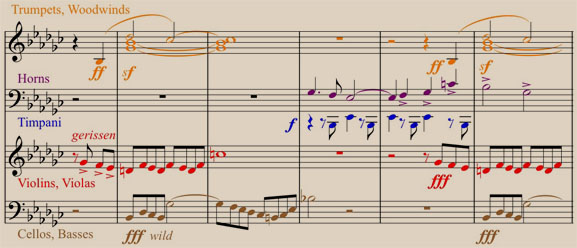Mahler's ingenious manipulations of harmony and texture gave a sense of momentum, freshness, and dramatic surprise to even the longest movements.
 Play
Play
Mahler pushes his orchestra to emulate the expressivity of the human voice. He marks his parts with very detailed dynamics, bowings, articulations, and other instructions. Here, he gets the cellos to sigh by playing glissando, sliding from one note to the next. In the First Symphony, the rest of the orchestra stand still while the cellos ask a searching question, using the alternation of major and minor harmonies to convey the expressive meaning.
 Play
Play
Mahler made a daring harmonic leap back to the home key of D Major in the First Symphony’s Finale. He described the creative process that led to the breathtaking moment: Again and again, the music had fallen from brief glimpses of light into the darkest depths of despair. Now, an enduring, triumphal victory had to be won. As I discovered after considerable vain groping, this could be achieved by modulating from one key to the key a whole tone above (from C major to D major, the principal key of the movement). Now, this could have been managed very easily by using the intervening semitone and rising from C to C sharp, then to D. But everyone would have known that D would be the next step. My D chord, however, had to sound as though it had fallen from heaven, as though it had come from another world. Then I found my transition — the most unconventional and daring of modulations, which I hesitated to accept for a long time and to which I finally surrendered much against my will. And if there is anything great in the whole symphony, it is this very passage, which — I can safely say it — has yet to meet its match.

Mahler’s command of counterpoint was rooted in his study of the past, but he used it in a uniquely expressive way. Essential to the effect was clarity of line: "In true polyphony the themes run side by side quite independently, each from its own source to its own particular goal and as strongly contrasted to one another as possible, so that they are heard quite separately."
Mahler was devoted to the effortless lyricism and dramatic power of the music of his fellow Viennese Franz Schubert. Both composers were preoccupied with the way in which the tonality of a passage could hang between major and minor.
-
Listen to the opening of Schubert’s last string quartet.
-
Compare this passage, which acts like a motto for the pessimistic mood of the Sixth Symphony: underlined by a fate-like rhythm in the drums, the brief trumpet-colored glow of a major chord gives way to a plaintive minor chord of oboes.
-
Here it is again, near the very end of the symphony, underlining the tragically powerful descent of the strings' melody.

-
In the Ninth Symphony's Rondo-Burleske, ideas appear and disappear like bubbles in boiling liquid. The music is as quirky in its sense of key as it is resourceful in part–writing, illustrating Mahler's maxim "Variety and contrast! That is, as it always was, the secret of effectiveness!" Is Mahler challenging his critics with music that is indeed “too clever by half"?